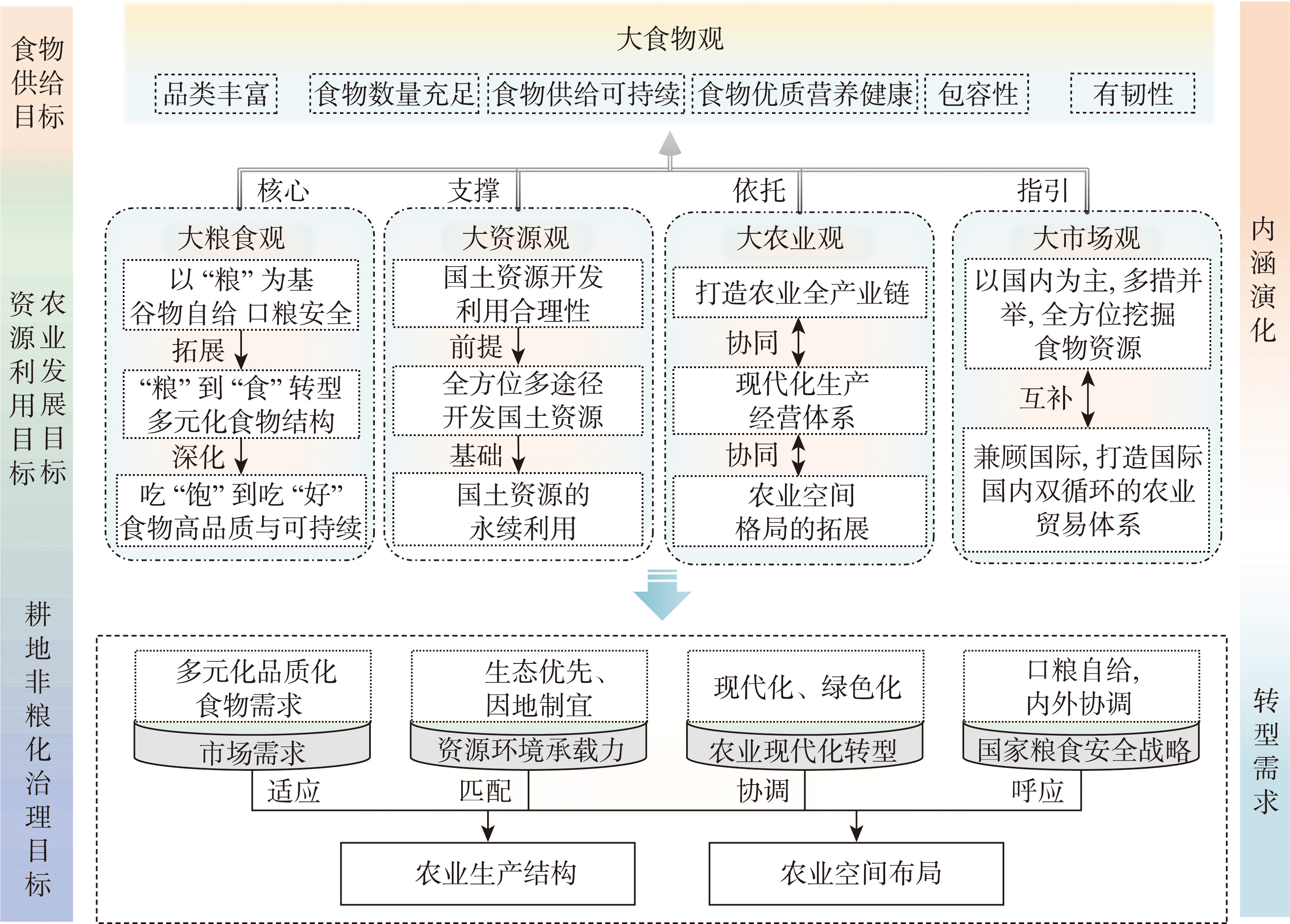

大食物观视域下耕地“非粮化”治理:逻辑、挑战与策略
|
李惠敏(1996-),男,山西稷山人,博士研究生,研究方向为土地资源管理。E-mail: l_hm@webmail.hzau.edu.cn |
收稿日期: 2024-07-29
修回日期: 2024-09-15
网络出版日期: 2025-04-16
基金资助
国家自然科学基金项目(42171263)
教育部人文社会科学一般项目(21YJA630033)
农业农村部种植业管理司项目(152410004)
华中农业大学乡村振兴研究专项(2662024YJ002)
The governance of "Non-grain Conversion" of cultivated land from the perspective of the greater food approach: Logic, challenges and strategies
Received date: 2024-07-29
Revised date: 2024-09-15
Online published: 2025-04-16
大食物观对耕地“非粮化”治理的理念深化、内涵拓展、目标转型和策略演进等提出了转型要求与更高标准,基于大食物观视域下重新审视耕地“非粮化”治理,不仅有助于改善粮食供需失衡态势,也可为保障国家安全提供基础支撑。研究发现:(1)大食物观视域下耕地“非粮化”的中心问题并不在于“粮”与“非粮”的二元对立,而是“大粮食观”下多元食物品类间的合理配置。(2)大食物观与耕地“非粮化”治理在理论逻辑上具有根本目标和价值取向一致性、理论缘起与实践遵循同源性,决定了二者在实践逻辑上具有交互联动性;树立大食物观是耕地“非粮化”治理的指导与遵循,耕地“非粮化”治理是践行大食物观的基础与途径。(3)大食物观视域下耕地“非粮化”治理面临种植结构调整滞后,粮食重要程度与收益梯度倒挂、增产瓶颈与损耗浪费并存、普适整改举措与地方特殊性错位等问题。(4)综合藏粮于地、藏粮于种、藏粮于技、藏粮于损与藏粮于策,提出大食物观下耕地“非粮化”系统治理的“五藏协同”策略。立足于大食物观的多元需求和整体视域系统推进治理策略优化,可为开展农食系统多维转型背景下耕地“非粮化”治理的理论深化和实践探索提供有益参考。

李惠敏 , 陈子文 , 张亦弛 , 王晓诺 , 王晨奇 , 胡银根 . 大食物观视域下耕地“非粮化”治理:逻辑、挑战与策略[J]. 自然资源学报, 2025 , 40(5) : 1194 -1211 . DOI: 10.31497/zrzyxb.20250504
The greater food approach sets forth elevated requisites and novel benchmarks for the advancement of conceptualization, expansion of connotations, transformation of objectives, and evolution of strategies in the governance of non-grain conversion of cultivated land. A reevaluation of "Non-grain Conversion" of cultivated land governance through the greater food approach not only aids in rectifying the imbalance in food supply and demand, but also establishes a fundamental underpinning for national security assurance. Findings reveal that: (1) The crux of "Non-grain Conversion" of cultivated land under the greater food approach lies not in the dichotomy of "grain" versus "non-grain" but rather in the judicious allocation of diverse food categories within the framework of the greater food approach. (2) The greater food approach and "Non-grain Conversion" of cultivated land governance in the theoretical logic of the fundamental goal and value orientation consistency, theoretical origin and practice to follow the same origin, determines the two in the practical logic of interaction and linkage, embracing the greater food approach serves as the guiding ethos for "Non-grain Conversion" of cultivated land governance, constituting the bedrock and avenue for enacting the greater food approach. (3) Governance of "Non-grain Conversion" of cultivated land under the greater food approach encounters challenges such as lagging adjustments in planting structures, an inverted significance of grain and income gradients, simultaneous existence of production bottlenecks and wastage, as well as incongruences between universally applicable rectification measures and localized idiosyncrasies. (4) Proposals encompass five overarching strategies for systematized governance of "Non-grain Conversion" of cultivated land oriented towards the greater food approach, focusing on the preservation of grain within land, crops, techniques, losses, and policies. Grounded in the multifaceted demands and holistic outlook of the greater food approach, the optimization of governance strategies proffers invaluable insights for the theoretical refinement and practical exploration of "Non-grain Conversion" of cultivated land governance amidst the backdrop of a multidimensional transformation in the agricultural and food system.

| [1] |
郁静娴. 全方位夯实粮食安全根基. 人民日报, 2024-06-04(1).
[
|
| [2] |
|
| [3] |
杜国明, 范晓雨, 于凤荣. 耕地“非粮化” 演化机制与治理策略: 基于刺激—反应模型的案例研究. 中国土地科学, 2023, 37(8): 52-61.
[
|
| [4] |
|
| [5] |
张婕, 刘玉洁, 张二梅, 等. 中国县域耕地动态演变及其驱动机制. 地理学报, 2023, 78(9): 2105-2127.
[
|
| [6] |
曹振. 耕地“非粮化”治理的实践困境及法治进路. 西北农林科技大学学报: 社会科学版, 2024, 24(2): 43-53.
[
|
| [7] |
李蕊, 陈柯之. 粮食安全视角下耕地“非粮化”的规制研究. 中国农民合作社, 2022, (4): 60-62.
[
|
| [8] |
|
| [9] |
邹金浪, 刘陶红, 张传, 等. 中国耕地食物生产变迁及“非粮化” 影响评估. 中国土地科学, 2022, 36(9): 29-39.
[
|
| [10] |
|
| [11] |
黄建伟, 张兆亮. 地方政府参与耕地流转“非粮化” 的逻辑及其治理: 基于耕地种树绿化的案例研究. 中国土地科学, 2023, 37(1): 114-123.
[
|
| [12] |
陈浮, 华子宜, 马静, 等. 耕地非粮化对土壤健康的影响及其机理: 以徐州市城乡结合部为例. 资源科学, 2023, 45(11): 2210-2221.
[
|
| [13] |
|
| [14] |
程国强. 大食物观: 结构变化、政策涵义与实践逻辑. 农业经济问题, 2023, 44(5): 49-60.
[
|
| [15] |
樊胜根. 大食物观引领农食系统转型全方位夯实粮食安全根基. 农村.农业. 农民, 2023, (2): 10-12.
[
|
| [16] |
朱晶, 李天祥. 中国式现代化下的粮食安全: 目标任务、转型挑战与实现路径. 学海, 2024, (2): 85-97.
[
|
| [17] |
宋敏, 张安录. 大食物观视阈下的耕地利用转型: 现实挑战、理论逻辑与实现路径. 中国土地科学, 2023, 37(8): 31-41.
[
|
| [18] |
朱晓华, 张燕, 朱媛媛. 大食物观视角下中国耕地保护的分区调控与区间协同. 地理学报, 2023, 78(9): 2147-2162.
[
|
| [19] |
陈浮, 李宇航, 于昊辰, 等. “大食物观” 统领国土空间开发和保护格局重塑. 中国土地科学, 2023, 37(4): 1-10.
[
|
| [20] |
武舜臣, 赵策, 胡凌啸. 转变中的粮食安全观: 理论期待与新粮食安全观的构建. 农业经济问题, 2022, 43(3): 17-28.
[
|
| [21] |
蓝红星, 李芬妮. 基于大食物观的“藏粮于地” 战略: 内涵辨析与实践展望. 中州学刊, 2022, (12): 49-56.
[
|
| [22] |
袁源, 王亚华, 徐萍. “非粮化” 治理视角下的耕地用途管制: 应对逻辑与体系构建. 自然资源学报, 2024, 39(4): 942-959.
[
|
| [23] |
樊志远, 孙云舒. 论大食物观的科学内涵、价值意蕴与实践要求. 西北农林科技大学学报: 社会科学版, 2023, 23(6): 68-75.
[
|
| [24] |
|
| [25] |
陈锡文. 当前农业农村的若干重要问题. 中国农村经济, 2023, (8): 2-17.
[
|
| [26] |
王芳, 贾晋. 大食物观视角下的食物安全: 理论内涵、指数测度与远景模拟. 农业经济问题, 2024, https://doi.org/10.13246/j.cnki.iae.20240717.001.
[
|
| [27] |
贾如. 以大食物观保障粮食安全: 互动机理、逻辑溯源与时代意旨. 西北农林科技大学学报: 社会科学版, 2024, 24(4): 63-73.
[
|
| [28] |
刘长全, 韩磊, 李婷婷, 等. 大食物观下中国饲料粮供给安全问题研究. 中国农村经济, 2023, (1): 33-57.
[
|
| [29] |
戈大专, 孙攀, 周贵鹏, 等. 传统农区粮食生产转型机制及其安全效应: 基于乡村空间治理视角. 自然资源学报, 2021, 36(6): 1588-1601.
[
|
| [30] |
陈浮, 沈春竹, 郭维红, 等. 大食物观下多元化食物供给和耕地保护协同推进: 逻辑、机制与路径. 中国土地科学, 2024, 38(6): 1-10.
[
|
| [31] |
周国华, 龙花楼, 林万龙, 等. 新时代“三农” 问题和乡村振兴的理论思考与实践发展. 自然资源学报, 2023, 38(8): 1919-1940.
[
|
| [32] |
杨一单, 姚成胜, 高云鹏, 等. 中国口粮自给率的区域非均衡特征及空间收敛. 资源科学, 2024, 46(4): 786-800.
[
|
| [33] |
刘科, 黄博琛. 大食物观: 超越粮食安全战略的时代价值与实践方案. 中州学刊, 2023, (5): 67-73.
[
|
| [34] |
毛瑞男, 邢浩特. 大食物观下我国粮食安全保障路径研究. 学习与探索, 2024, (2): 127-135.
[
|
| [35] |
武舜臣. 粮食安全保障与稻麦“三量齐增” 应对: 中国玉米和日本稻米改革的经验启示. 经济学家, 2018, (4): 96-103.
[
|
| [36] |
张亨明, 黄锦程. 我国粮食结构性问题及其消解方略. 吉首大学学报: 社会科学版, 2023, 44(5): 66-74.
[
|
| [37] |
刘靖文, 侯丽薇, 杨艳涛. 中国玉米供需平衡及国际市场可利用性分析. 中国农业资源与区划, 2021, 42(4): 126-133.
[
|
| [38] |
|
| [39] |
王越, 孔令宇, 高丹桂, 等. 生产要素视角下粮食主产区利益补偿机制研究: 以东北粮食主产区为例. 中国农村经济, 2024, (6): 117-135.
[
|
| [40] |
|
| [41] |
裴瑞敏, 张超, 陈凯华, 等. 完善我国农作物种业国家创新体系促进创新链产业链深度融合. 中国科学院院刊, 2022, 37(7): 967-976.
[
|
| [42] |
高利伟, 成升魁, 曹晓昌, 等. 食物损失和浪费研究综述及展望. 自然资源学报, 2015, 30(3): 523-536.
[
|
| [43] |
赵渺希, 师浩辰, 李昕, 等. 城乡居民食材消耗的多尺度地域差异及政策启示: 基于烟台、兰州、新乡、九江家庭食谱的实证分析. 自然资源学报, 2022, 37(10): 2636-2650.
[
|
| [44] |
王灵恩, 倪笑雯, 李云云, 等. 中国消费端食物浪费规模及其资源环境效应测算. 自然资源学报, 2021, 36(6): 1455-1468.
[
|
| [45] |
成升魁, 李云云, 刘晓洁, 等. 关于新时代我国粮食安全观的思考. 自然资源学报, 2018, 33(6): 911-926.
[
|
| [46] |
王明利. 有效破解粮食安全问题的新思路: 着力发展牧草产业. 中国农村经济, 2015, (12): 63-74.
[
|
| [47] |
杨智慧, 路欣怡, 孔祥斌, 等. 中国耕地刚性管制与弹性调控框架构建. 中国土地科学, 2021, 35(6): 11-19.
[
|
| [48] |
牛帅, 胡业翠, 陈星鑫, 等. 国土空间“三线” 冲突视角下耕地管控刚性与弹性空间划定. 农业工程学报, 2024, 40(13): 222-232.
[
|
/
| 〈 |
|
〉 |